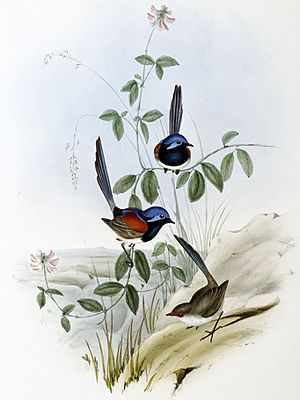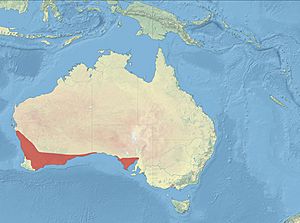Blue-breasted fairywren facts for kids
Quick facts for kids Blue-breasted fairywren |
|
|---|---|
 |
|
| Conservation status | |
| Scientific classification | |
 |
|
| Distribution of the blue-breasted fairywren |
The blue-breasted fairywren (Malurus pulcherrimus) is a small, colorful bird. It belongs to the Australasian wren family, called Maluridae. These birds do not migrate, meaning they stay in the same area all year. They are found only in southern Western Australia and the Eyre Peninsula in South Australia.
Male and female blue-breasted fairywrens look very different. This is called sexual dimorphism. During breeding season, the male bird is very bright. He has a bright blue head, blue ear patches, and a blue upper back. His shoulders are red, and his throat is dark blue. His tail and wings are grey-brown, and his belly is pale. Females, young birds, and males not in breeding season are mostly grey-brown. There are no different types (subspecies) of this bird.
Contents
About the Blue-breasted Fairywren
Naming the Bird
The blue-breasted fairywren was first described in 1844 by John Gould. He was a famous bird expert. The bird's scientific name, pulcherrimus, comes from Latin. It means "very pretty."
This bird is one of eleven species in the group called Malurus. These birds are commonly known as fairywrens. They live in Australia and parts of New Guinea. The blue-breasted fairywren is part of a group of four similar species. These are called the chestnut-shouldered fairywrens. The other three are the lovely fairywren, the variegated fairywren, and the red-winged fairywren. Scientists have studied their DNA. They found that the blue-breasted fairywren is most closely related to the red-winged fairywren.
Fairywrens are not related to the "true wrens" found in other parts of the world. For a long time, scientists were unsure where to place them. In 1975, they were put into their own family, the Maluridae. More recent DNA studies show that this family is related to honeyeaters and pardalotes. They all belong to a larger group called Meliphagoidea.
How They Evolved
Scientists believe that the chestnut-shouldered fairywrens started in the northern parts of Australia. From there, they slowly spread south. This happened during a time when the climate was warmer and wetter. This was about 2 million years ago. As the climate changed and became cooler and drier, their homes became separated.
Birds in the southwest became the red-winged fairywren. Those in the northwest became the variegated fairywren. Later, warmer and wetter weather allowed birds to spread south again. This group, which settled in central southern Australia, became the blue-breasted fairywren. When the climate got cooler again, these birds also became isolated. This led them to become a separate species. Today, after the last ice age, the different types of variegated fairywrens have spread south again. This means that the areas where all three species live now overlap.
What They Sound Like
The blue-breasted fairywren has a soft, short call. It sounds a bit like a reed instrument. When there is danger, they make a typical fairywren alarm call. It's a short, churring sound. All the birds in the group will repeat this sound. The males' song is not very strong. It's a soft, buzzing sound. They usually sing from a hidden spot deep inside bushes.
Where They Live
The blue-breasted fairywren lives in inland south-western Western Australia. They are also found on the Eyre Peninsula in South Australia. At first, people thought they only lived in Western Australia. But later, they were found further east. For a while, people thought they were a type of variegated wren there. It's interesting that there's a 300-kilometer gap in their range. They are not found from the Great Australian Bight to the Eyre Peninsula.
How They Live
The blue-breasted fairywren is not a very common bird. They are also quite shy. This makes them hard to spot. However, if you imitate a fairywren distress call, the females might come out. The adult males are even shyer than the females. You usually only catch a quick glimpse of them hiding in the bushes.
Raising Their Young
Their breeding season is quite short, from August to November. This means they usually only raise one group of babies (clutch) per year. Sometimes they might raise two. Only the females have been seen building nests. They also sit on the eggs and care for the young birds. It takes about a week to build a nest. A typical nest has three creamy, oval-shaped eggs. These eggs have reddish-brown spots and blotches, especially on the wider end.
Not much is known about how long the eggs take to hatch. Also, how the young are raised is not fully known. But it is probably similar to other fairywrens. Both parents, and other birds in their family group, have been seen feeding the baby birds.
If their nest or young are in danger, both male and female adults use a special trick. They do a "rodent-run" display. This means they pretend to be a small animal running away. This distracts predators from their nest.
What They Eat
Blue-breasted wrens mostly find their food on the ground. They eat small insects and other tiny creatures. This includes beetles, grubs, ants, weevils, flies, and wasps.
See also
 In Spanish: Maluro pechiazul para niños
In Spanish: Maluro pechiazul para niños


